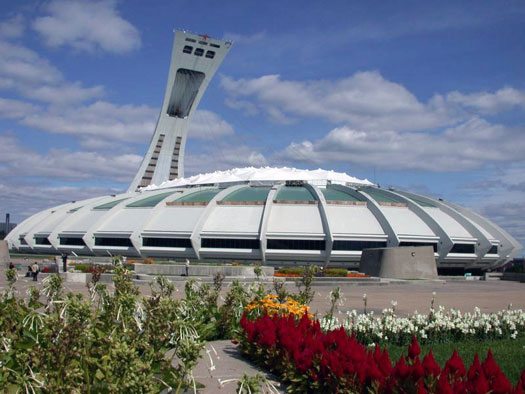
August 3, 2017; New York Times
Over 4,300 asylum seekers have crossed into Canada from the United States since the beginning of the year, fearing they will never become legal due to President Trump’s efforts to cut back on travel to the country and increase deportations of migrants already there. In response, Canadian authorities have established a temporary housing space for them in Montreal’s Olympic stadium.
The public hall of the 56,000-seat stadium has been transformed into a shelter with 150 cots and room for hundreds more. Concession stands have turned into food preparation stations, and the stadium has a number of amenities, including showers and Internet service.
Although it has been used for various types of events over the years, the stadium has not had a main tenant since the Montreal Expos baseball team left for Washington, D.C., in 2004, where they became the Washington Nationals. What may seem like an ignominious development for a once-illustrious building, however, could actually offer a new, more constructive life for the “white elephant”—part of a creative “adaptive reuse” trend sweeping the world, including the United States and Europe.
“In the evolution of historic cities, we see play out over and over the lessons of adaptive reuse, at once economic (as through the capitalization of existing assets) and environmental (for example, the conservation of embodied energy and building materials),” writes the U.S. National Committee of the International Council on Monuments and Sites (US/ICOMOS). “Rehabilitating older building stock is more cost efficient than new construction and utilizes existing infrastructure while providing safe shelter.” Consider:
Sign up for our free newsletters
Subscribe to NPQ's newsletters to have our top stories delivered directly to your inbox.
By signing up, you agree to our privacy policy and terms of use, and to receive messages from NPQ and our partners.
Reuse of public buildings
- An abandoned 6,000-square-foot textile factory in Thessaloniki, Greece, has been turned into a housing and medical facility for refugees. The Elpída Home Project, done in partnership with the Radcliffe Foundation, opened July 24th and houses around 160 refugees, with room for 700 when operating at full capacity. Refugees co-manage the facility alongside volunteers. Individual housing units have been constructed on the large, open factory floors, along with common spaces equipped with electricity, running water and kitchens.
- A government agency in the Netherlands has opened empty prisons to accommodate the influx of migrants seeking asylum. With the country’s crime rate and prison population on a years-long steady decline, dozens of correctional facilities have closed. When more than 50,000 entered the Netherlands last year alone, the Central Agency for the Reception of Asylum Seekers saw a solution.
- In the United States, which to date has resisted accepting what some consider its fair share of refugees, a similar solution is being used to provide affordable housing and services for homeless people and lower-income residents. One of the most popular types of repurposed buildings are schools. As the Chicago Tribune reports, “Finding new uses for closed schools has become a national priority as cities across the country, especially in the Midwest and Northeast, shutter hundreds of the buildings—a trend that’s expected to continue.” Nonprofits are finding many efficient ways to put those vacant buildings to work. In Kansas City, for example, a community radio station broadcasts from the second floor of one school purchased by a nonprofit. Local sports teams practice on the grounds and community groups use the first-floor space in exchange for helping out with chores. In Chicago, a school that became a community center rents space to local churches and to a nonprofit that serves food to the homeless.
New residents for vacant homes
Homes are, of course, another type of vacant building. According to the National Alliance to End Homelessness, more than 560,000 people experienced homelessness on any given night in the United States as of January 2015. And yet they’re outnumbered by vacant homes—an estimated 18.5 million across the country. A growing number of activists are calling for these empty houses to be occupied with the humans living on America’s streets.
Europe is no different. “All across Europe, cities are facing vacant property crises due to massive population decline. In 2014, there were an estimated 11 million vacant homes across Europe—more than 3.4 million in Spain, over 2 million in both France and Italy, 1.8 million in Germany, and more than 700,000 in the UK,” states the US/ICOMOS report. At the same time, there are 4.1 million homeless living across the European continent.
Of course, whether the properties in question be underused stadiums or abandoned homes, there are valid concerns about using substandard, unhealthy buildings without appropriate rehabilitation (which requires scarce funds) and the downsides of concentrating challenged populations in one area.
“While it is hard to imagine that living in tents or other makeshift spaces is a better option for refugees [or the homeless], ghettoization is certainly a legitimate concern. Only time will tell if this kind of arrangement, focused on large clustering versus integration, is a good option given the sense of urgency and the overwhelming number of individuals needing homes,” writes US/ICOMOS. Moreover, vacant buildings carry their own costs. They are easy targets for thieves and other criminal activity, for instance.
However, many experiments have shown that with creative use of funds and broad community engagement, adaptive reuse can provide a solution to declining “legacy” populations and the world’s growing humanitarian crises. While each city has a unique set of circumstances, steps, like an inventory of all of these buildings and their readiness for occupancy, could be taken now to get ahead of the curve.—Pam Bailey













